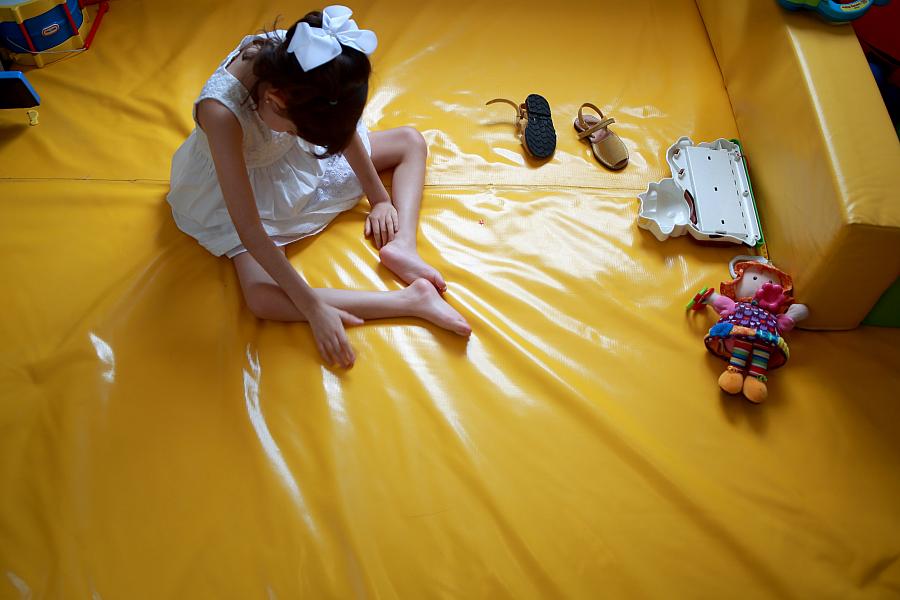Despite gains, the emotional lives of children often forgotten by our medical system

I don’t remember the date, or even the time of year, though the medical records tell me it was 1977.
I was 6.
But I will always remember that day: the gloomy, wood-paneled exam room at Karolinska Institutet in Stockholm, the hard, high table I sat on, the doctor looming above me as he muttered about swan necks and hammers, though there were no birds or tools in sight.
He didn’t bother making eye contact with me. I’m not sure he even made it with my mother and grandfather, who were just two of the many adults present.
My mother and I were the only civilians. My grandfather was a pediatric radiologist. It was thanks to him that I received my diagnosis of juvenile idiopathic arthritis (JIA) from one of the most prominent in the field, at least in Sweden.
That diagnosis turned out to be a life sentence, since unlike some of the 300,000 children in this country currently diagnosed with JIA, I never outgrew the condition. But honestly, what was hardest to deal with during that time was not the pain, or the exhaustion, or the decreasing mobility, or the medicines that hurt my stomach.
It was the unnerving silence from all the adults, and their apparent unwillingness to engage with me as a person, not a broken thing.
To be fair, I know I got the best physical care available. But sadly, that complete lack of concern about how this affected me emotionally continued as I grew older. I quickly became cowed when my peers were cruel over my increasingly swan-necked fingers and hammertoes, unable to offer them an explanation other than arthritis, which to them was something only their grandparents got. Even some adults, believing arthritis only afflicted the elderly, argued with me about my diagnosis.
This may seem unconscionable in 2019. Mindfulness and self-care have become mantras in our culture, inspiring myriad articles and books. And those 300,000 JIA patients, at least in this country, now have resources I never had, like pediatric specialists, and online and real-life support groups, and summer camps tailored for their condition. This is cheering. But in spite of all these gains, many children and parents still find their emotional lives overlooked by the medical establishment. And considering one in four children in this country has a chronic condition, the human costs are high.
The progress we have seen in this arena stems partly from medical advances: 40 years ago, survival rates for sick children, whether those with cancer, diabetes, or asthma, weren’t great. It wasn’t until the late ’80s that studies started popping up about children with chronic illness needing more emotional support. Medicine had advanced enough by then that many more of these children were making it to adulthood and living largely normal lives. But they were having trouble coping emotionally.
That doesn’t mean some child patients back then weren’t getting emotional help. Then as now, the help they received largely depended on the diagnosis. Whether a given doctor specialized in children, and the patient’s age at diagnosis, also made a difference, according to many of the testimonials I’ve come across in my reporting and research.
Diabetes is a great example of a condition with far better emotional supports. Before 1921, when researchers discovered a way to synthesize insulin, Type 1 diabetes, often diagnosed in childhood, was a death sentence.
By the 1980s, though, young patients were regularly referred by hospitals to support groups and summer camps, where they could not just get emotional help from peers but learn practical ways to manage the condition.
Would juvenile arthritis camp (those started around the time I started college) have helped me? Perhaps. Or perhaps I would have had a similar experience to Maris Kreizman, whose less-than-stellar summer at a diabetes camp was shared on Longreads:
“A malfunctioning pancreas was supposed to be all I needed in common with these girls in order for us to become best friends forever,” she writes. “I’d never wanted diabetes to be a core part of my identity, and forcing friendships defined by matching prescriptions for insulin felt shallow.”
Still, Kreizman is lucky to have such support offered to her at all, particularly from the medical establishment, because not everyone is given that option. For example, Washington writer Phoebe Moses Holmes’ daughter had epilepsy from age 4 to 10. (She has been in remission for the past six years.)
“It never even occurred to me that they would be concerned about her emotional state,” she said, echoing another parent with a similar experience who declined to speak on the record about their son. “They never encouraged me to explain anything.”
But hearing from other parents and children that experiences like these aren’t necessarily the norm today (one even reported to me that her daughter’s pediatric rheumatologist was so concerned about her patient’s mental health that she ignored her physical pain) is cheering, even though there is clearly still work to do. At least many medical institutions, including children’s hospitals, disease foundations and doctor’s organizations are getting on board, recommending that doctors engage young patients, and their parents, in lots of dialogue.
“The more information parents and children have, the less frightening the present and future will seem,” writes the American Academy of Pediatrics in a piece called “Living with a Chronic Illness or Disability.”
That’s great advice, and I wonder: How much pain would I have been spared if the adults around me had followed it?

